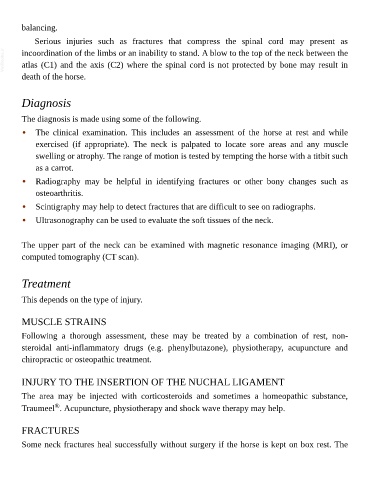Page 531 - The Veterinary Care of the Horse
P. 531
balancing.
Serious injuries such as fractures that compress the spinal cord may present as
VetBooks.ir incoordination of the limbs or an inability to stand. A blow to the top of the neck between the
atlas (C1) and the axis (C2) where the spinal cord is not protected by bone may result in
death of the horse.
Diagnosis
The diagnosis is made using some of the following.
• The clinical examination. This includes an assessment of the horse at rest and while
exercised (if appropriate). The neck is palpated to locate sore areas and any muscle
swelling or atrophy. The range of motion is tested by tempting the horse with a titbit such
as a carrot.
• Radiography may be helpful in identifying fractures or other bony changes such as
osteoarthritis.
• Scintigraphy may help to detect fractures that are difficult to see on radiographs.
• Ultrasonography can be used to evaluate the soft tissues of the neck.
The upper part of the neck can be examined with magnetic resonance imaging (MRI), or
computed tomography (CT scan).
Treatment
This depends on the type of injury.
MUSCLE STRAINS
Following a thorough assessment, these may be treated by a combination of rest, non-
steroidal anti-inflammatory drugs (e.g. phenylbutazone), physiotherapy, acupuncture and
chiropractic or osteopathic treatment.
INJURY TO THE INSERTION OF THE NUCHAL LIGAMENT
The area may be injected with corticosteroids and sometimes a homeopathic substance,
®
Traumeel . Acupuncture, physiotherapy and shock wave therapy may help.
FRACTURES
Some neck fractures heal successfully without surgery if the horse is kept on box rest. The

